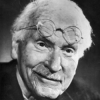Carl Jung

Carl Jung
Carl Gustav Jungwas a Swiss psychiatrist and psychotherapist who founded analytical psychology. His work has been influential not only in psychiatry but also in philosophy, anthropology, archaeology, literature, and religious studies. He was a prolific writer, though many of his works were not published until after his death...
NationalitySwiss
ProfessionScientist
Date of Birth26 July 1875
CityKesswil, Switzerland
CountrySwitzerland
However far-fetched it may sound, experience shows that many neuroses are caused by the fact that people blind themselves to their own religious promptings because of a childish passion for rational enlightenment.
I don't believe there is a God. I know there is a God.
I came to Freud for facts. I read 'The Interpretation of Dreams' and I thought- 'Oh, here is a man who is not just theorizing away, here is a man who has got facts.
St. Thomas is really a great man quite apart from his saintliness.
The totality of the psyche can never be grasped by the intellect alone.
The answer to human life is not to be found within the limits of human life.
I saw that everything, all paths I had been following, all steps I had taken, were leading back to a single point - namely, to the mid-point. It became increasingly plain to me that the mandala is the center. It is the exponent of all paths. It is the path to the center, to individuation. I knew that in finding the mandala as an expression of the self I had attained what was for me the ultimate.
Life is a luminous pause between two mysteries that are yet one.
I live in my deepest hell and from there I cannot fall any further.
No concept is a carrier of life.
Life calls not for perfection, but for completeness.
I studiously avoided all so-called "holy men." I did so because I had to make do with my own truth, not accept from others what I could not attain on my own. I would have felt it as a theft had I attempted to learn from the holy men and to accept their truth for myself. Neither in Europe can I make any borrowings from the East, but must shape my life out of myself-out of what my inner being tells me, or what nature brings to me.
In the last analysis, the essential thing is the life of individual. This alone makes history, here alone do the great transformations take place, and the whole future, the whole history of the world, ultimately springs as a gigantic summation from these hidden source in individuals.
When you succeed in awakening the Kundalini, so that it starts to move out of its mere potentiality, you necessarily start a world which is totally different from our world. It is the world of eternity.